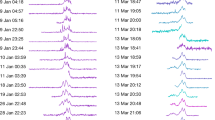Abstract
THE flux densities of 35 non-thermal radio sources were measured at 8,000 Mc/s (λ 3.75 cm) with the University of Michigan's 85-ft. reflector. Comparison of these measurements with the spectra of the sources at frequencies less than 3,200 Mc/s (ref. 1) showed that most spectra were either straight (constant spectral index) or curved downward (steepening spectrum) at the high-frequency end of the spectrum. However, the radio source 3C 84 which has been identified with the Seyfert galaxy NGC 1275 (refs. 2 and 3) was found to have a flux density at 8,000 Mc/s which was four times greater than that expected from a straight line extrapolation of the spectrum observed at frequencies less than 3,200 Mc/s. This is the first reported instance of a radio spectrum having such a pronounced upward turn in its spectrum with increasing frequency. (The novel spectrum of NGC 1275 was first reported by us at the International Scientific Radio Union General Assembly in Tokyo, September 9–20, 1963.) Thus NGC 1275 may represent a new class of radio source spectra. The radio source 3C 279 was also investigated because a pronounced upward turn of its spectrum was predicted by J. A. Roberts from measurements up to 2,650 Mc/s; we found its spectrum to be similar to NGC 1275. A third source 3C 273 has a spectral flattening at the high frequency end, but does not have a positive spectral index as do the foregoing two sources.
This is a preview of subscription content, access via your institution
Access options
Subscribe to this journal
Receive 51 print issues and online access
$199.00 per year
only $3.90 per issue
Buy this article
- Purchase on Springer Link
- Instant access to full article PDF
Prices may be subject to local taxes which are calculated during checkout
Similar content being viewed by others
References
Conway, R. G., Kellerman, K. I., and Long, R. J., Mon. Not. Roy. Astro. Soc., 125, 261 (1963).
Baade, W., and Minkowski, R., Astrophys. J., 119, 215 (1954).
Baldwin, J. E., and Elmore, B., Nature, 173, 818 (1954).
Haddock, F. T., and Hobbs, R. W., Astro. J., 69, 140 (1964).
Lazarevskii, V. S., Stankevich, K. S., and Troitskii, V. S., Astr. Zhur, 40 12 (1963).
Kellerman, K. I., Astro. J., 69, 205 (1964).
Leslie, P. R. R., and Elsmore, B., Observatory, 81, 14 (1961).
Lynds, C. R., and Sobieski, S., Publ. Nat. Rad. Astro. Obs., 1, 155 (1961).
Boischot, A., Ginat, M., and Kazes, I., Ann. d'Ap., 26, 85 (1963).
Baars, J. W. M., Mezger, P. G., and Wendker, H. (following communication).
Heeschen, D. S., Astrophys. J., 133, 322 (1961).
Lequeux, J., Ann. d'Ap., 25, 221 (1962).
Based on Z = 0.018 from Humason, M. L., Mayall, N. U., and Sandage, A. R., Astro. J., 61, 97 (1956), and assuming H0 = 100 km sec−1 Mpc−1.
Seyfert, K., Astrophys. J., 97, 28 (1943).
Allen, L. R., Anderson, B., Conway, R. G., Palmer, H. P., Reddish, V. C., and Rowson, B., Mon. Not. Roy. Astro. Soc., 124, 477 (1962).
Maltby, P., and Moffet, A. T., Astrophys. J., Supp., 7, 141 (1962).
Hazard, C., Mackey, M. B., and Shimmins, A. J., Nature, 197, 1037 (1963).
Schmidt, M., Nature, 197, 1040 (1963).
Author information
Authors and Affiliations
Rights and permissions
About this article
Cite this article
DENT, W., HADDOCK, F. A New Class of Radio Source Spectra. Nature 205, 487–488 (1965). https://doi.org/10.1038/205487a0
Published:
Issue Date:
DOI: https://doi.org/10.1038/205487a0
This article is cited by
-
A rapid millimetre wave outburst in the nucleus of NGC1275
Nature (1983)
-
Physical Science: Excess Surface Density of Extragalactic Radio Sources at 8 GHz
Nature (1970)
-
Spectrum of the Radio Source 4C 50.11/NRAO 150
Nature (1968)
-
Variation of the Positional Angle of the Polarization Plane of Radiosources with Time
Nature (1967)
-
Angular Diameters of Some Radio Sources with Anomalous High-Frequency Spectra
Nature (1966)
Comments
By submitting a comment you agree to abide by our Terms and Community Guidelines. If you find something abusive or that does not comply with our terms or guidelines please flag it as inappropriate.



